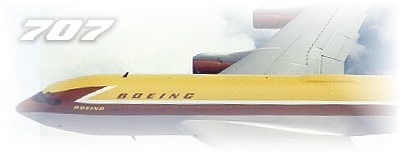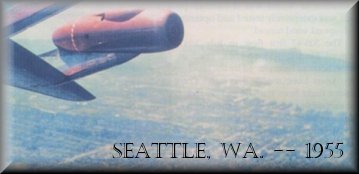

When it was unveiled back in 1954, Boeing's executives took a big business gamble and went all out to promote the new plane. During the 1955 Gold Cup Hydroplane Boat Race, Bill Allen, Boeing's President, had invited some aviation industry officials to his private Yacht on Lake Washington just outside of Seattle, and had made prior arrangements for the 707-prototype to make several low passes over the races. It was the perfect public relations opportunity, and the first time for the plane to be shown to a large crowd. More than 200,000 spectators, most of whom had never seen a passenger airliner or a jetliner, watched in great excitement as the 707 rushed towards them, barely preceded by the ear-piercing sound of it's engines. What they were about to see would exceed their wildest expectations and horrify Bill Allen!
With test pilot Tex Johnston at the controls, the 707 was flying along at 450 mph at about 400 feet AGL. Suddenly it's nose pitched up sharply to 35º and to everyone's shock, started rollling to the left. Shock turned to amazement and then to wild enthusiasm as the 707 majestically completed a giant, lazy, aileron roll that would have made any Stearman pilot proud! It swung around and flew by for another pass and delighted the crowd with another aileron roll, right over Bill Allen's Yacht! Allen was anything but delighted, and he was too stunned even to be angry.

However when Tex Johnston was being asked, he simply stated that the aileron roll is the tamest of all positive-G maneuvers. He had gently pulled a positive 1G and held it all the way around the roll. There was never a danger of the fuel and hydraulic flows being interrupted due to negative-G's, and the plane's extremely low negative-G limit of -1G was irrelevant to the maneuver. Nor was there a danger of any cast altitude loss at the end of the roll because if anyone knew how to fly a proper aileron roll everytime, he did! "That airplane never knew it wasn't flying straight and level" Johnston said. Johnston never understood what all the fuss was about. For him the aileron roll was what a standard rate turn is for an instrument pilot. He was just trying to sell airplanes by showing what they could do, he clamied.
BUT, things were different back then, especially if you wore snakeskin boots and a 10-gallon hat and were Boeing's best test pilot....
